Technologies Trend towards 5G Network for Smart Health-Care Using IoT: A Review
Abstract
1. Introduction
1.1. Our Contributions
- A taxonomy for smart health-care, covering communications technologies, network types, services, application, requirements, and characteristics.
- Different scenarios for 5G smart health-care and its requirements.
- Key enabling technologies to achieve the requirements of 5G smart health-care and open issues and challenges.
1.2. Organization of This Paper
2. Taxonomy
2.1. Communication Technologies
2.2. Network Types
2.3. IoT Health-Care Services
2.4. Health-Care Applications
2.5. Smart Health-Care Requirements
2.6. Characteristics of Smart Health-Care
3. Scenarios for 5G Network and Its Requirements
- Enhanced mobile broadband.
- Massive machine-type communications.
- High-reliability and low-latency communications.
- WRAN (Wireless Regional Area Networks).
3.1. Enhanced Mobile Broadband (EMB)
3.2. Massive Machine-Type Communications (MMTC)
3.3. Low-Latency and High-Reliability Communications
3.4. Wireless Regional Area Networks (WRAN)
4. Technology Trends to Achieve the Requirements in the 5G Network
4.1. Massive MIMO (Multiple-Input Multiple-Output) and 3D MIMO
4.2. Millimetre-Wave Communications
4.3. Small Cells, Ultra-Dense Networks, and Heterogeneous Networks
4.4. Device-To-Device (D2D) Communications
4.5. Cognitive Radio
4.6. Artificial Intelligence (AI) and Machine Learning (ML)
- For rapid decision making and low computation capability, the AI and ML algorithms can be embedded within individual edge devices in the network.
- For low latency IoT services, AI and ML engines at the network edge can play an important role in performing real-time computation and quick decision making.
- For huge data storage and heavy computation for the analysis of medical data, AI and ML can be embedded in the centralized system to achieve these goals.
5. Open Issues and Challenges
5.1. Achieving Interoperability
5.2. Analysis of Big Data
- For data analysis privacy must be provided to the user data.
- For sensitive data secrecy must be provided.
- For data collection and analysis, a well-defined infrastructure must be provided.
- For information extraction, computation power must be provided.
5.3. Performing IoT Connectivity
- Guaranteeing connectivity to the devices with high mobility (i.e., moving patient, high-speed ambulance) in the network.
- Providing connectivity to every device deployed in the network with both short and long-range.
5.4. Achieving Security, Trust and Privacy
- A secure and straightforward communication must be delivered between smart health-care devices and cloud database centre for data authenticity and integrity.
- Well-defined approach must be provided for risk assessment, to detect upcoming and present attacks.
- Strong privacy policy must be provided for new user approval and trust.
6. Conclusions
Author Contributions
Funding
Conflicts of Interest
Abbreviations
| BAN | Body Area Network |
| BS | Base Station |
| CMTC | Critical Machine Type Communication |
| CoT | Cloud of Things |
| CDMA | Code Division Multiple Access |
| CQI | Channel Quality Indicator |
| D2D | Device-to-Device |
| EMB | Enhanced Mobile Broadband |
| ETSI | European Telecommunications Standards Institute |
| FDMA | Frequency Division Multiple Access |
| GSM | Global System for Mobile |
| GPRS | General Packet Radio Service |
| HetNets | Heterogeneous Networks |
| IoT | Internet of Things |
| ITU | International Telecommunication Union |
| IECR | IoT European Research Cluster |
| LTE | Long-Term Evaluation |
| LTE-M | Long-Term Evaluation Advance |
| LoraWAN | Long Range Wide Area Network |
| Lora | Long Range |
| M2M | Machine-to-Machine |
| mMTC | Massive Machine-Type Communication |
| MTCs | Machine-Type Communications |
| MBS | Macro Base Station |
| MIMO | Multiple-input multiple output |
| NFV | Network Function Virtualization |
| NB-IoT | Narrowband Internet of Thing |
| NFC | Near Field Communication |
| OFDMA | Orthogonal Frequency Division Multiplexing |
| OMA | Open Mobile Alliance |
| QoS | Quality of Service |
| SNR | Signal-to-Noise Ratio |
| SBS | Small Base Station |
| SDN | Software Defined Network |
| TDMA | Time Division Multiple Access |
| TCP | Transmission Control Protocol |
| UHD | Ultra High Definition |
| UEs | User Equipment’s |
| URLLC | Ultra-Reliable and Low Latency Communication |
| WLAN | Wireless Local Area Network |
| WRAN | Wireless Regional Area Networks |
| WBAN | Wireless Body Area Network |
| WiMAX | Worldwide Interoperability for Microwave Access |
| Wi-Fi | Wireless Fidelity |
| 3GPP | Third Generation Partnership Project |
| 4G | Fourth Generation |
| 5G | Fifth Generation Mobile Network |
References
- Sundaravadivel, P.; Kougianos, E.; Mohanty, S.P.; Ganapathiraju, M.K. Everything you wanted to know about smart health care: Evaluating the different technologies and components of the Internet of Things for better health. IEEE Consum. Electron. Mag. 2017, 7, 18–28. [Google Scholar] [CrossRef]
- 2019 Global Health Care Outlook Shaping the Future—Deloitte. Available online: https://www2.deloitte.com/content/dam/Deloitte/global/Documents/Life-Sciences-Health-Care/gx-lshc-hc-outlook-2019.pdf (accessed on 10 June 2020).
- Liu, X.; Jia, M.; Zhang, X.; Lu, W. A novel multichannel Internet of things based on dynamic spectrum sharing in 5G communication. IEEE Internet Things J. 2018, 6, 5962–5970. [Google Scholar] [CrossRef]
- Li, D. 5G and intelligence medicine—How the next generation of wireless technology will reconstruct healthcare? Precis. Clin. Med. 2019, 2, 205–208. [Google Scholar] [CrossRef]
- Brito, J.M. Technological Trends for 5G Networks Influence of E-Health and IoT Applications. Int. J. Health Med Commun. (IJEHMC) 2018, 9, 1–22. [Google Scholar] [CrossRef]
- McCue, T.J. $117 billion market for the internet of things in healthcare by 2020. Forbes Tech. 2015. Available online: https://www.forbes.com/sites/tjmccue/2015/04/22/117-billion-market-for-internet-of-things-in-healthcare-by-2020 (accessed on 10 June 2020).
- Rodrigues, J.J.; Pedro, L.M.; Vardasca, T.; de la Torre-Díez, I.; Martins, H.M. Mobile health platform for pressure ulcer monitoring with electronic health record integration. Health Informatics J. 2013, 19, 300–311. [Google Scholar] [CrossRef]
- Rodrigues, J.J.; Lopes, I.M.; Silva, B.M.; Torre, I.D. A new mobile ubiquitous computing application to control obesity: SapoFit. Informatics Health Soc. Care 2013, 38, 37–53. [Google Scholar] [CrossRef]
- Silva, B.M.; Rodrigues, J.J.; Lopes, I.M.; Machado, T.M.; Zhou, L. A novel cooperation strategy for mobile health applications. IEEE J. Sel. Areas Commun. 2013, 31, 28–36. [Google Scholar] [CrossRef]
- Yang, G.; Urke, A.R.; Øvsthus, K. Mobility Support of IoT Solution in Home Care Wireless Sensor Network. In Proceedings of the 2018 Ubiquitous Positioning, Indoor Navigation and Location-Based Services (UPINLBS), Wuhan, China, 22–23 March 2018; pp. 475–480. [Google Scholar]
- Santos, J.; Rodrigues, J.J.; Silva, B.M.; Casal, J.; Saleem, K.; Denisov, V. An IoT-based mobile gateway for intelligent personal assistants on mobile health environments. J. Netw. Comput. Appl. 2016, 71, 194–204. [Google Scholar] [CrossRef]
- Vilela, P.H.; Rodrigues, J.J.; Solic, P.; Saleem, K.; Furtado, V. Performance evaluation of a Fog-assisted IoT solution for e-Health applications. Future Gener. Comput. Syst. 2019, 97, 379–386. [Google Scholar] [CrossRef]
- Ahad, A.; Al Faisal, S.; Ali, F.; Jan, B.; Ullah, N. Design and Performance Analysis of DSS (Dual Sink Based Scheme) Protocol for WBASNs. Adv. Remote Sens. 2017, 6, 245. [Google Scholar] [CrossRef]
- Ojaroudi Parchin, N.; Jahanbakhsh Basherlou, H.; Al-Yasir, Y.I.; Abd-Alhameed, R.A.; Abdulkhaleq, A.M.; Noras, J.M. Recent developments of reconfigurable antennas for current and future wireless communication systems. Electronics 2019, 8, 128. [Google Scholar] [CrossRef]
- Parchin, N.O.; Abd-Alhameed, R.A. Acompact Vivaldi antenna array for 5G channel sounding applications. In Proceedings of the 12th European Conference on Antennas and Propagation (EuCAP 2018), London, UK, 9–13 April 2018; pp. 9–13. [Google Scholar]
- Parchin, N.O. Low-profile air-filled antenna for next generation wireless systems. Wirel. Pers. Commun. 2017, 97, 3293–3300. [Google Scholar] [CrossRef]
- Ojaroudi Parchin, N.; Alibakhshikenari, M.; Jahanbakhsh Basherlou, H.; AAbd-Alhameed, R.; Rodriguez, J.; Limiti, E. MM-wave phased array quasi-Yagi antenna for the upcoming 5G cellular communications. Appl. Sci. 2019, 9, 978. [Google Scholar] [CrossRef]
- Ojaroudiparchin, N.; Shen, M.; Pedersen, G.F. Wide-scan phased array antenna fed by coax-to-microstriplines for 5G cell phones. In Proceedings of the 2016 21st International Conference on Microwave, Radar and Wireless Communications (MIKON), Krakow, Poland, 9–11 May 2016; pp. 1–4. [Google Scholar]
- Mohammad, A.; Virdee, B.S.; See, C.H.; Abd-Alhameed, R.A.; Falcone, F.; Ernesto, L. High-Gain Metasurface in polyimide on-chip Antenna Based on cRLH-tL for Sub-terahertz integrated circuits. Sci. Rep. 2020, 10, 1–9. [Google Scholar]
- Saeidi-Manesh, H.; Zhang, G. Hybrid Feed Microstrip Patch Array Antenna for MPAR Application. In Proceedings of the 2017 IEEE International Symposium on Antennas and Propagation & USNC/URSI National Radio Science Meeting, San Diego, CA, USA, 9–14 July 2017. [Google Scholar]
- Saeidi-Manesh, H.; Zhang, G. Low cross-polarization, high-isolation microstrip patch antenna array for multi-mission applications. IEEE Access 2018, 7, 5026–5033. [Google Scholar] [CrossRef]
- Alibakhshi-Kenari, M.; Naser-Moghadasi, M.; Sadeghzadeh, R.A.; Virdee, B.S.; Limiti, E. Periodic array of complementary artificial magnetic conductor metamaterials-based multiband antennas for broadband wireless transceivers. IET Microwaves Antennas Propag. 2016, 10, 1682–1691. [Google Scholar] [CrossRef]
- Saeidi-Manesh, H.; Zhang, G. Challenges and Limitations of the Cross-Polarization Suppression in Dual-Polarization Antenna Arrays using Identical Subarrays. IEEE Trans. Antennas Propag. 2019, 68, 2853–2866. [Google Scholar] [CrossRef]
- Alibakhshikenari, M.; Virdee, B.S.; See, C.H.; Abd-Alhameed, R.; Ali, A.H.; Falcone, F.; Limiti, E. Study on isolation improvement between closely-packed patch antenna arrays based on fractal metamaterial electromagnetic bandgap structures. IET Microwaves Antennas Propag. 2018, 12, 2241–2247. [Google Scholar] [CrossRef]
- Alibakhshikenari, M.; Virdee, B.S.; Shukla, P.; See, C.H.; Abd-Alhameed, R.; Khalily, M.; Falcone, F.; Limiti, E. Antenna mutual coupling suppression over wideband using embedded periphery slot for antenna arrays. Electronics 2018, 7, 198. [Google Scholar] [CrossRef]
- Agiwal, M.; Saxena, N.; Roy, A. Towards connected living: 5G enabled internet of things (IoT). IETE Tech. Rev. 2019, 36, 190–202. [Google Scholar] [CrossRef]
- Palattella, M.R.; Dohler, M.; Grieco, A.; Rizzo, G.; Torsner, J.; Engel, T.; Ladid, L. Internet of things in the 5G era: Enablers, architecture, and business models. IEEE J. Sel. Areas Commun. 2016, 34, 510–527. [Google Scholar] [CrossRef]
- Chih-Lin, I.; Han, S.; Xu, Z.; Sun, Q.; Pan, Z. 5G: Rethink mobile communications for 2020+. Philosophical Trans. R. Soc. A Math. Phys. Eng. Sci. 2016, 374, 20140432. [Google Scholar] [CrossRef] [PubMed]
- Ahad, A.; Tahir, M.; Yau, K.L. 5G-Based Smart Healthcare Network: Architecture, Taxonomy, Challenges and Future Research Directions. IEEE Access 2019, 7, 100747–100762. [Google Scholar] [CrossRef]
- Mahmoud, M.M.; Rodrigues, J.J.; Ahmed, S.H.; Shah, S.C.; Al-Muhtadi, J.F.; Korotaev, V.V.; De Albuquerque, V.H.C. Enabling technologies on cloud of things for smart healthcare. IEEE Access 2018, 6, 31950–31967. [Google Scholar] [CrossRef]
- Qi, J.; Yang, P.; Min, G.; Amft, O.; Dong, F.; Xu, L. Advanced internet of things for personalised healthcare systems: A survey. Pervasive Mob. Comput. 2017, 41, 132–149. [Google Scholar] [CrossRef]
- Dhanvijay, M.M.; Patil, S.C. Internet of Things: A survey of enabling technologies in healthcare and its applications. Comput. Netw. 2019, 153, 113–131. [Google Scholar] [CrossRef]
- Baker, S.B.; Xiang, W.; Atkinson, I. Internet of things for smart healthcare: Technologies, challenges, and opportunities. IEEE Access 2017, 5, 26521–26544. [Google Scholar] [CrossRef]
- Mehmood, Y.; Ahmad, F.; Yaqoob, I.; Adnane, A.; Imran, M.; Guizani, S. Internet-of-things-based smart cities: Recent advances and challenges. IEEE Commun. Mag. 2017, 55, 16–24. [Google Scholar] [CrossRef]
- Islam, S.R.; Kwak, D.; Kabir, M.H.; Hossain, M.; Kwak, K.S. The internet of things for health care: A comprehensive survey. IEEE Access 2015, 3, 678–708. [Google Scholar] [CrossRef]
- Jara, A.J.; Belchi, F.J.; Alcolea, A.F.; Santa, J.; Zamora-Izquierdo, M.A.; Gómez-Skarmeta, A.F. A Pharmaceutical Intelligent Information System to detect allergies and Adverse Drugs Reactions based on internet of things. In Proceedings of the 2010 8th IEEE International Conference on Pervasive Computing and Communications Workshops (PERCOM Workshops), Mannheim, Germany, 29 March–2 April 2010; pp. 809–812. [Google Scholar]
- Rohokale, V.M.; Prasad, N.R.; Prasad, R. A cooperative Internet of Things (IoT) for rural healthcare monitoring and control. In Proceedings of the 2011 2nd International Conference on Wireless Communication, Vehicular Technology, Information Theory and Aerospace and Electronic Systems Technology (Wireless VITAE), Chennai, India, 28 February–3 March 2011; pp. 1–6. [Google Scholar]
- You, L.; Liu, C.; Tong, S. Community medical network (CMN): Architecture and implementation. In Proceedings of the 2011 Global Mobile Congress, Shanghai, China, 17–18 October 2011; pp. 1–6. [Google Scholar]
- Chung, W.Y.; Lee, Y.D.; Jung, S.J. A wireless sensor network compatible wearable u-healthcare monitoring system using integrated ECG, accelerometer and SpO2. In Proceedings of the 2008 30th Annual International Conference of the IEEE Engineering in Medicine and Biology Society, Vancouver, BC, Canada, 20–25 August 2008; pp. 1529–1532. [Google Scholar]
- Castillejo, P.; Martinez, J.F.; Rodriguez-Molina, J.; Cuerva, A. Integration of wearable devices in a wireless sensor network for an E-health application. IEEE Wirel. Commun. 2013, 20, 38–49. [Google Scholar] [CrossRef]
- Faisal, A.I.; Majumder, S.; Mondal, T.; Cowan, D.; Naseh, S.; Deen, M.J. Monitoring Methods of Human Body Joints: State-of-the-Art and Research Challenges. Sensors 2019, 19, 2629. [Google Scholar] [CrossRef] [PubMed]
- Rasid, M.F.; Musa, W.M.; Kadir, N.A.; Noor, A.M.; Touati, F.; Mehmood, W.; Khriji, L.; Al-Busaidi, A.; Mnaouer, A.B. Embedded gateway services for Internet of Things applications in ubiquitous healthcare. In Proceedings of the 2014 2nd International Conference on Information and Communication Technology (ICoICT), Bandung, Indonesia, 28–30 May 2014; pp. 145–148. [Google Scholar]
- De Brouwer, M.; Ongenae, F.; Bonte, P.; De Turck, F. Towards a Cascading Reasoning Framework to Support Responsive Ambient-Intelligent Healthcare Interventions. Sensors 2018, 18, 3514. [Google Scholar] [CrossRef]
- Viswanathan, H.; Chen, B.; Pompili, D. Research challenges in computation, communication, and context awareness for ubiquitous healthcare. IEEE Commun. Mag. 2012, 50, 92–99. [Google Scholar] [CrossRef]
- Kiran, M.S.; Rajalakshmi, P.; Acharyya, A. Context predictor based sparse sensing technique and smart transmission architecture for IoT enabled remote health monitoring applications. In Proceedings of the 2014 36th Annual International Conference of the IEEE Engineering in Medicine and Biology Society, Chicago, IL, USA, 26–30 August 2014; pp. 4151–4154. [Google Scholar]
- Mosa, A.S.; Yoo, I.; Sheets, L. A systematic review of healthcare applications for smartphones. BMC Med. Informatics Decis. Mak. 2012, 12, 67. [Google Scholar] [CrossRef] [PubMed]
- Istepanian, R.S.; Hu, S.; Philip, N.Y.; Sungoor, A. The potential of Internet of m-health Things “m-IoT” for non-invasive glucose level sensing. In Proceedings of the 2011 Annual International Conference of the IEEE Engineering in Medicine and Biology Society, Boston, MA, USA, 30 August–3 September 2011; pp. 5264–5266. [Google Scholar]
- Liu, S.H.; Lin, C.B.; Chen, Y.; Chen, W.; Huang, T.S.; Hsu, C.Y. An EMG Patch for the Real-Time Monitoring of Muscle-Fatigue Conditions During Exercise. Sensors 2019, 19, 3108. [Google Scholar] [CrossRef]
- Guan, Z.J. Internet-of-Things human body data blood pressure collecting and transmitting device. Chin. Pat. 2013, 202, 362. [Google Scholar]
- Curran, K.; Mansell, G.; Curran, J. An IoT Framework for Detecting Movement Within Indoor Environments. In International Conference on Machine Learning for Networking; Springer: Cham, Switzerland, 2018; pp. 333–340. [Google Scholar]
- Mi, Z.; Wei, G. A CoAP-Based Smartphone Proxy for Healthcare with IoT Technologies. In Proceedings of the 2018 IEEE 9th International Conference on Software Engineering and Service Science (ICSESS), Beijing, China, 23–25 November 2018; pp. 271–278. [Google Scholar]
- Tabish, R.; Ghaleb, A.M.; Hussein, R.; Touati, F.; Mnaouer, A.B.; Khriji, L.; Rasid, M.F. A 3G/WiFi-enabled 6LoWPAN-based U-healthcare system for ubiquitous real-time monitoring and data logging. In Proceedings of the 2014 Middle East Conference on Biomedical Engineering (MECBME), Doha, Qatar, 17–20 February 2014; pp. 277–280. [Google Scholar]
- Fan, Y.J.; Yin, Y.H.; Da Xu, L.; Zeng, Y.; Wu, F. IoT-based smart rehabilitation system. IEEE Trans. Ind. Inf. 2014, 10, 1568–1577. [Google Scholar]
- Pang, Z.; Tian, J.; Chen, Q. Intelligent packaging and intelligent medicine box for medication management towards the Internet-of-Things. In Proceedings of the 16th International Conference on Advanced Communication Technology, Pyeong Chang, Korea, 16–19 February 2014; pp. 352–360. [Google Scholar]
- Yang, L.; Ge, Y.; Li, W.; Rao, W.; Shen, W. A home mobile healthcare system for wheelchair users. In Proceedings of the 2014 IEEE 18th International Conference on Computer Supported Cooperative Work in Design (CSCWD), Hsinchu, Taiwan, 21–23 May 2014; pp. 609–614. [Google Scholar]
- Pesta, M.; Fichtl, J.; Kulda, V.; Topolcan, O.; Treska, V. Monitoring of circulating tumor cells in patients undergoing surgery for hepatic metastases from colorectal cancer. Anticancer Res. 2013, 33, 2239–2243. [Google Scholar]
- Hii, P.C.; Chung, W.Y. A comprehensive ubiquitous healthcare solution on an Android™ mobile device. Sensors 2011, 11, 6799–6815. [Google Scholar] [CrossRef]
- Syed, R.A. Next Generation and Advanced Network Reliability Analysis; Springer: Cham, Switzerland, 2019; pp. 1–27. [Google Scholar]
- Bader, A.; Ghazzai, H.; Kadri, A.; Alouini, M.S. Front-end intelligence for large-scale application-oriented internet-of-things. IEEE Access 2016, 4, 3257–3272. [Google Scholar] [CrossRef]
- Ahad, A.; Ullah, Z.; Amin, B.; Ahmad, A. Comparison of Energy Efficient Routing Protocols in Wireless Sensor Network. Am. J. Netw. Commun. 2017, 6, 67–73. [Google Scholar] [CrossRef]
- Yu, H.; Lee, H.; Jeon, H. What is 5G? Emerging 5G mobile services and network requirements. Sustainability 2017, 9, 1848. [Google Scholar] [CrossRef]
- Al-Falahy, N.; Alani, O.Y. Technologies for 5G networks: Challenges and opportunities. IT Prof. 2017, 19, 12–20. [Google Scholar] [CrossRef]
- Li, C.P.; Jiang, J.; Chen, W.; Ji, T.; Smee, J. 5G ultra-reliable and low-latency systems design. In Proceedings of the 2017 European Conference on Networks and Communications (EuCNC), Oulu, Finland, 12–15 June 2017; pp. 1–5. [Google Scholar]
- Gupta, A.; Jha, R.K. A survey of 5G network: Architecture and emerging technologies. IEEE Access 2015, 3, 1206–1232. [Google Scholar] [CrossRef]
- Kartun-Giles, A.; Jayaprakasam, S.; Kim, S. Euclidean matchings in ultra-dense networks. IEEE Commun. Lett. 2018, 22, 1216–1219. [Google Scholar] [CrossRef]
- Usama, M.; Erol-Kantarci, M. A Survey on Recent Trends and Open Issues in Energy Efficiency of 5G. Sensors 2019, 19, 3126. [Google Scholar] [CrossRef]
- Elijah, O.; Leow, C.Y.; Rahman, T.A.; Nunoo, S.; Iliya, S.Z. A comprehensive survey of pilot contamination in massive MIMO-5G system. IEEE Commun. Surv. Tutor. 2015, 18, 905–923. [Google Scholar] [CrossRef]
- Prasad, K.S.; Hossain, E.; Bhargava, V.K. Energy efficiency in massive MIMO-based 5G networks: Opportunities and challenges. IEEE Wirel. Commun. 2017, 24, 86–94. [Google Scholar] [CrossRef]
- Zhang, J.A.; Huang, X.; Dyadyuk, V.; Guo, Y.J. Massive hybrid antenna array for millimetre-wave cellular communications. IEEE Wirel. Commun. 2015, 22, 79–87. [Google Scholar] [CrossRef]
- Wei, L.; Hu, R.Q.; Qian, Y.; Wu, G. Key elements to enable millimetre wave communications for 5G wireless systems. IEEE Wirel. Commun. 2014, 21, 136–143. [Google Scholar]
- Rajoria, S.; Trivedi, A.; Godfrey, W.W. A comprehensive survey: Small cell meets massive MIMO. Phys. Commun. 2018, 26, 40–49. [Google Scholar] [CrossRef]
- Ibrahim, L.F.; Salman, H.A.; Taha, Z.F.; Akkari, N.; Aldabbagh, G.; Bamasak, O. A survey on heterogeneous mobile networks planning in indoor dense areas. Pers. Ubiquitous Comput. 2019, 1–12. [Google Scholar] [CrossRef]
- Li, S.; Da Xu, L.; Zhao, S. 5G Internet of Things: A survey. J. Ind. Inf. Integr. 2018, 10, 1–9. [Google Scholar] [CrossRef]
- Muthanna, A.; Masek, P.; Hosek, J.; Fujdiak, R.; Hussein, O.; Paramonov, A.; Koucheryavy, A. Analytical evaluation of D2D connectivity potential in 5G wireless systems. In The Internet of Things, Smart Spaces, and Next Generation Networks and Systems; Springer: Cham, Switzerland, 2016; pp. 395–403. [Google Scholar]
- Hossain, E.; Hasan, M. 5G cellular: Key enabling technologies and research challenges. arXiv 2015, arXiv:1503.00674. [Google Scholar] [CrossRef]
- Liu, X.; Zhang, X. NOMA-based Resource Allocation for Cluster-based Cognitive Industrial Internet of Things. IEEE Trans. Ind. Informatics 2019, 16, 5379–5388. [Google Scholar] [CrossRef]
- Amjad, M.; Rehmani, M.H.; Mao, S. Wireless multimedia cognitive radio networks: A comprehensive survey. IEEE Commun. Surv. Tutor. 2018, 20, 1056–1103. [Google Scholar] [CrossRef]
- El-Gayar, O.F.; Ambati, L.S.; Nawar, N. Wearables, Artificial intelligence, and the Future of Healthcare. In AI and Big Data’s Potential for Disruptive Innovation; IGI Global: Hershey, PA, USA, 2020; pp. 104–129. [Google Scholar]
- Noura, M.; Atiquzzaman, M.; Gaedke, M. Interoperability in internet of things: Taxonomies and open challenges. Mob. Netw. Appl. 2019, 24, 796–809. [Google Scholar] [CrossRef]
- Hossain, M.S.; Muhammad, G. Emotion-aware connected healthcare big data towards 5G. IEEE Internet Things J. 2017, 5, 2399–2406. [Google Scholar] [CrossRef]
- Nguyen, K.T.; Laurent, M.; Oualha, N. Survey on secure communication protocols for the Internet of Things. Ad Hoc Netw. 2015, 32, 17–31. [Google Scholar] [CrossRef]
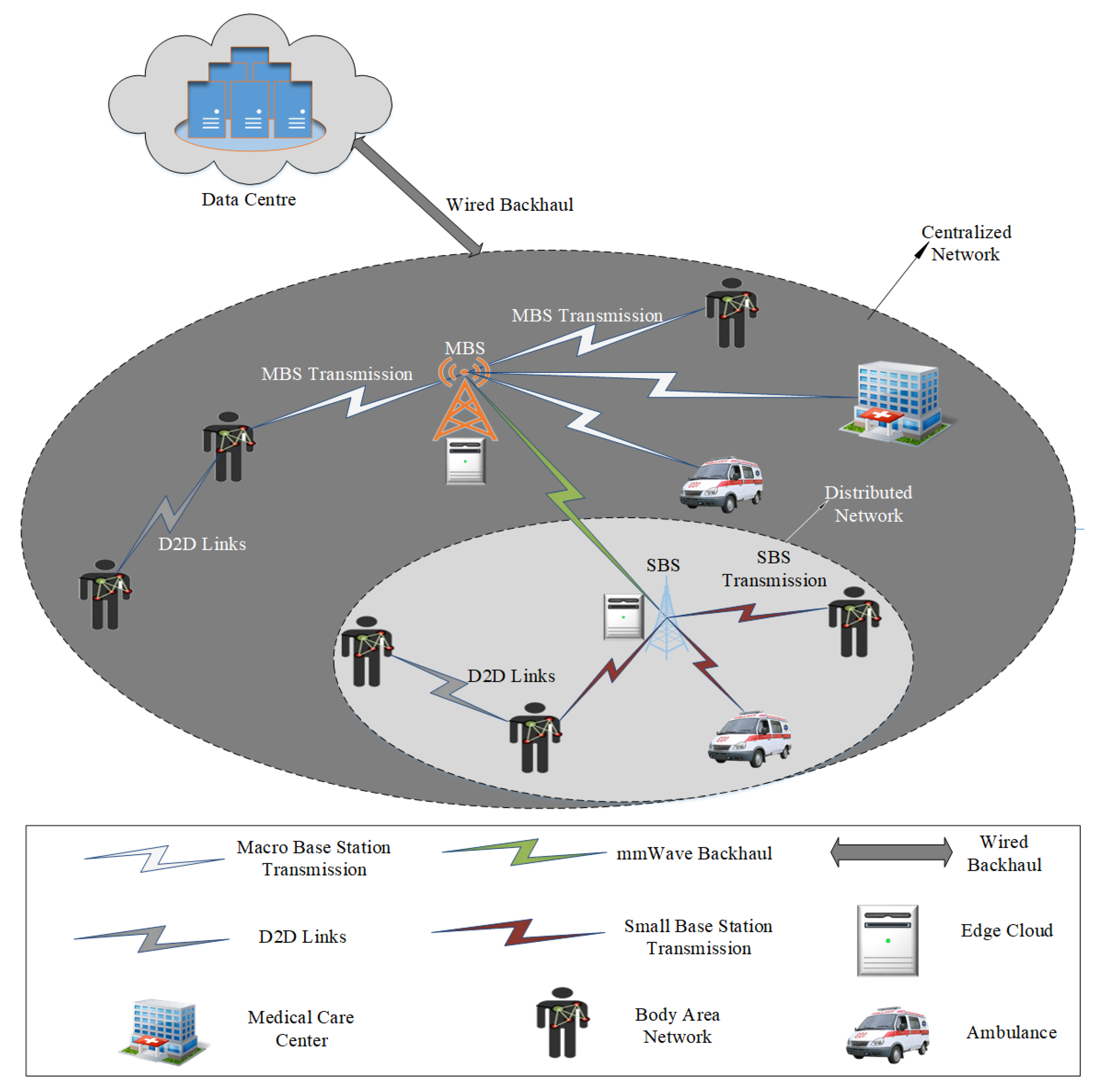
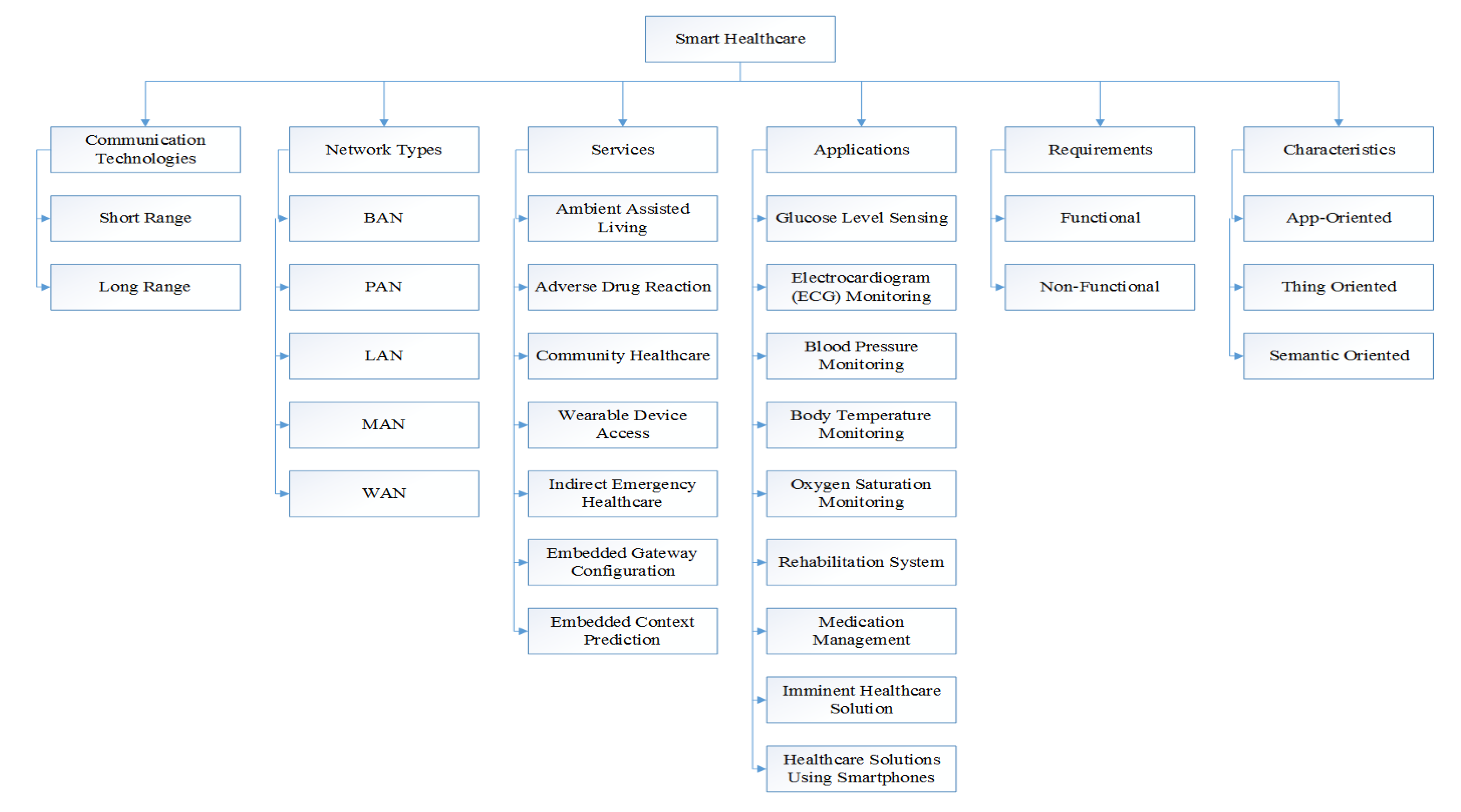
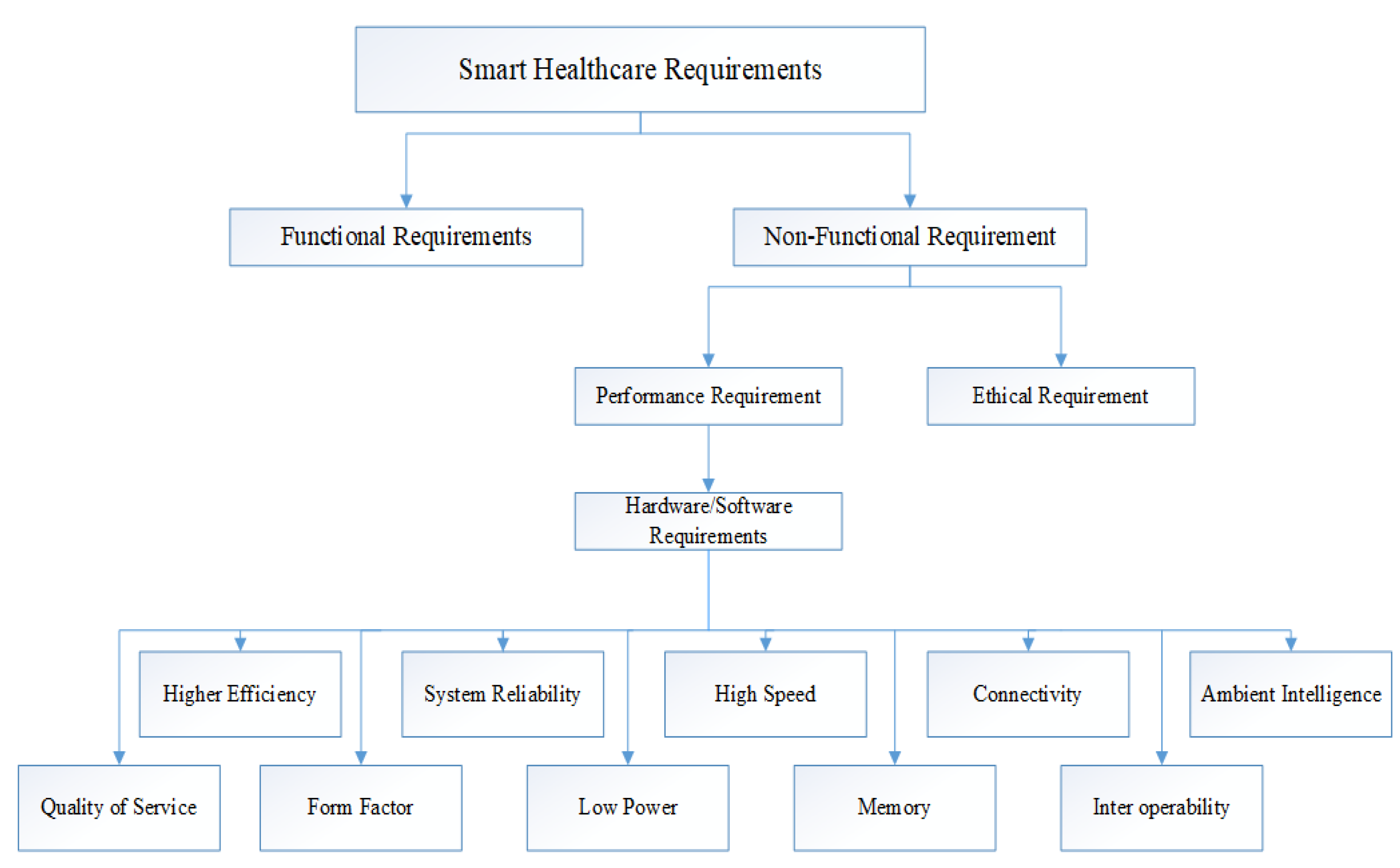
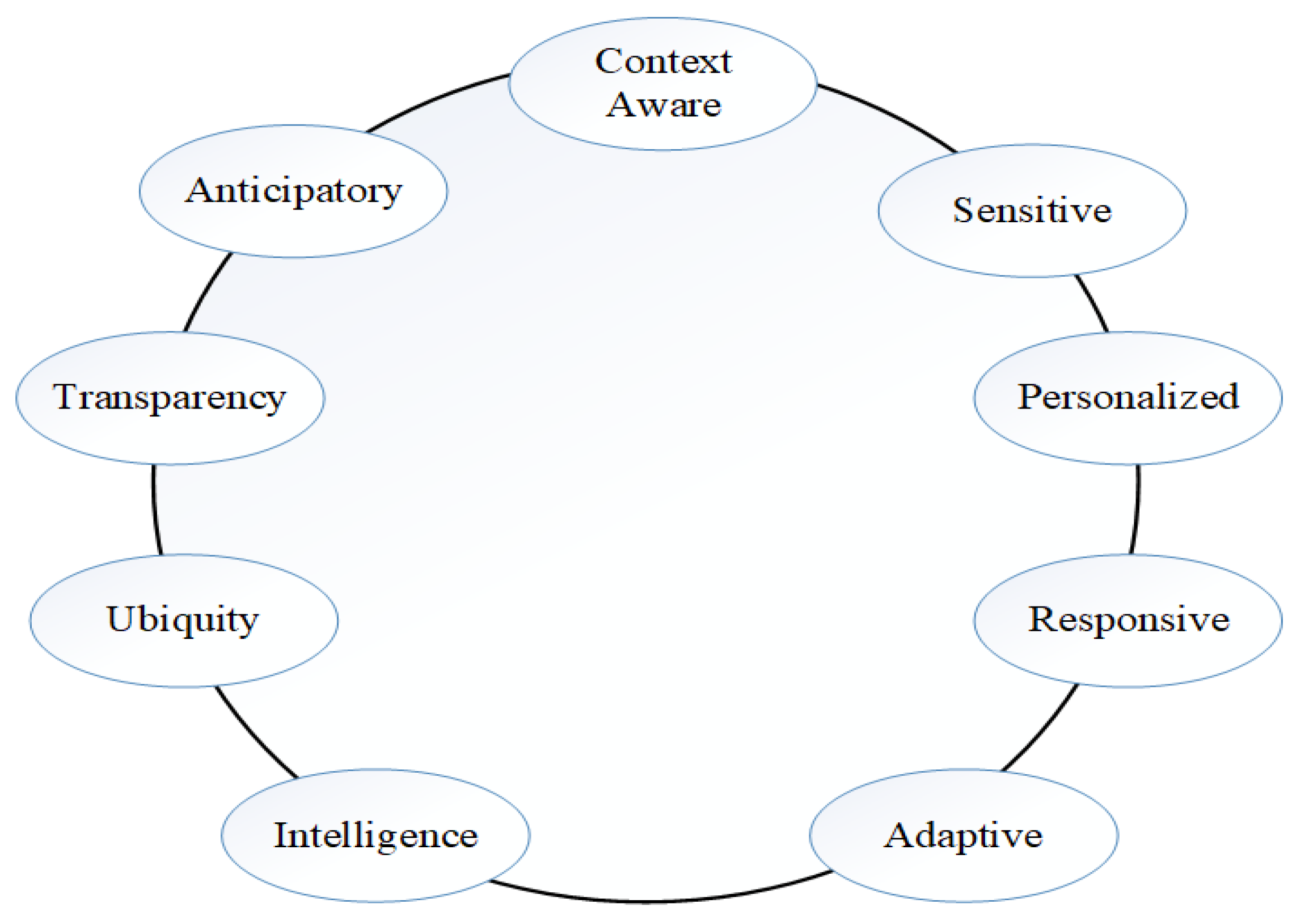
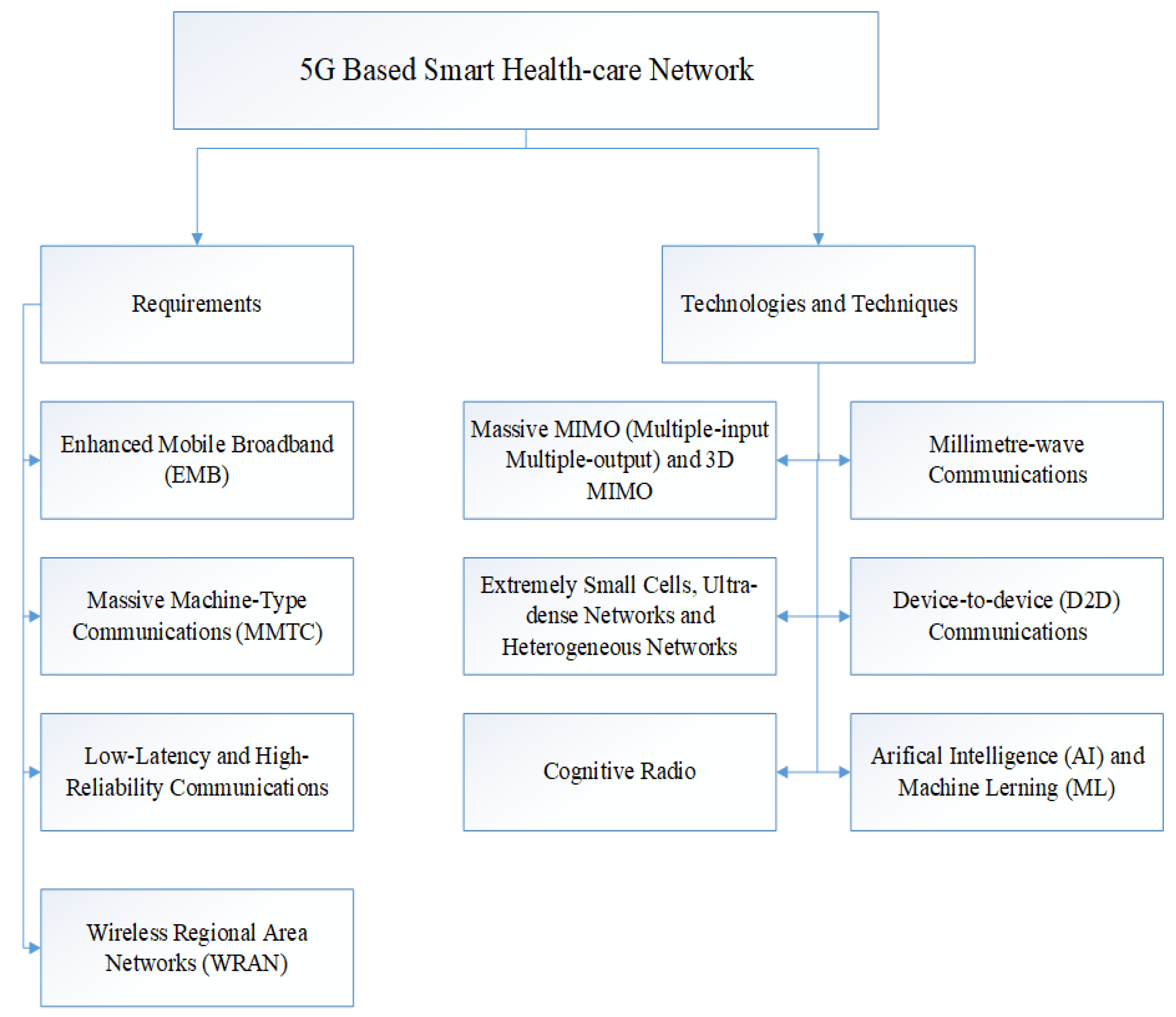
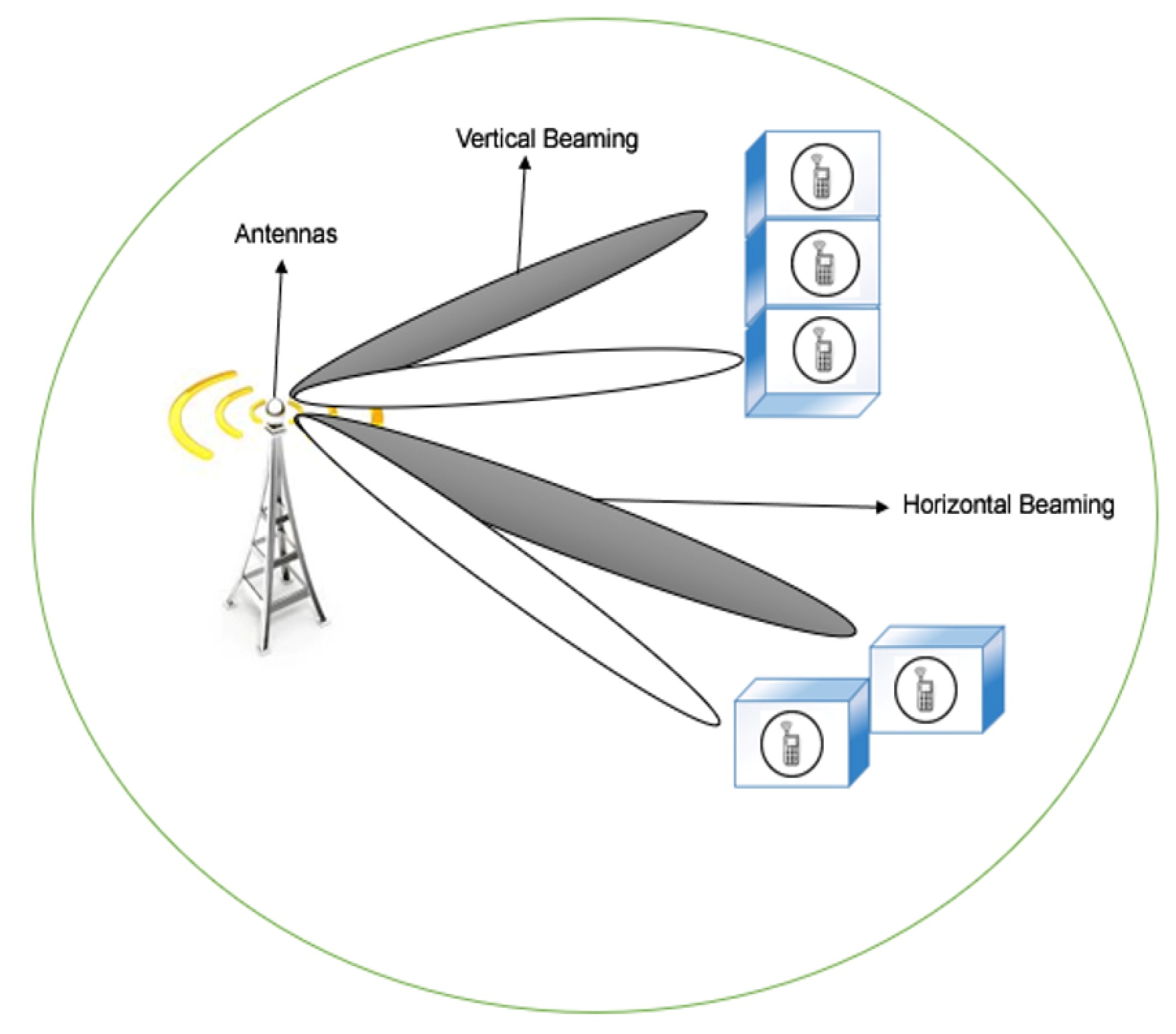
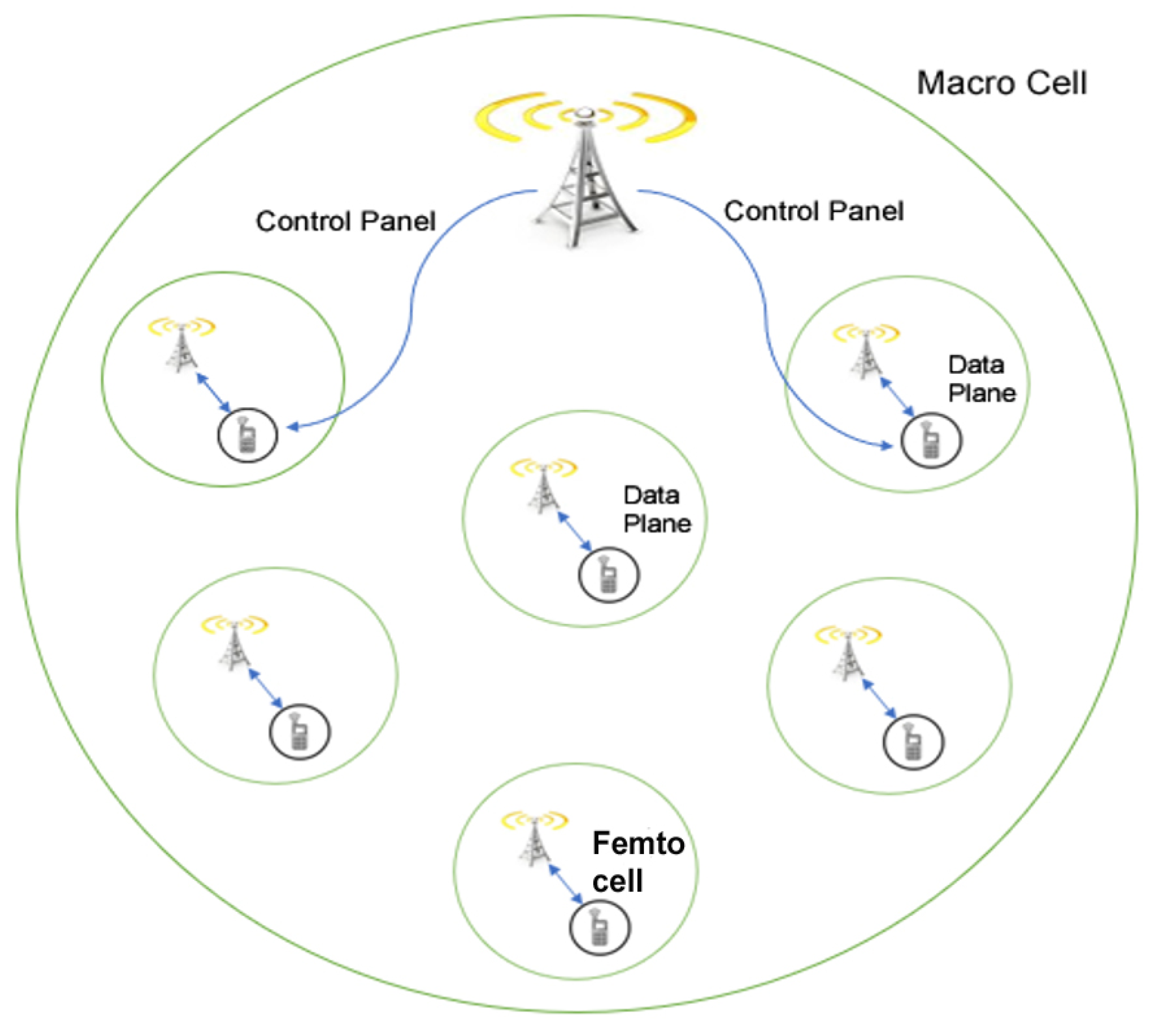

| References | Contributions of Authors |
|---|---|
| Ahad et al. [29] | In this review, the author presented architecture and taxonomy of smart health-care network based on 5G covering the communication technologies, objectives, performance measures, and requirements. Secondly, the author presented a detailed overview of different approaches, such as scheduling and routing, to achieve different objectives and requirements of smart health-care. Finally, the author presented open issues and challenges related to smart health-care. |
| Mahmoud et al. [30] | In this review, the author presented a review on Cloud of Things (CoT) and how to improved smart health-care applications with the help of CoT. Secondly, the author gave a detailed review of different issues, such as energy efficiency with CoT for smart health-care applications. |
| Qi et al. [31] | In this review, the author examines different applications of IoT with respect to smart health-care with various aspects (i.e., heartbeat monitoring, oxygen, blood pressure monitoring, oxygen saturation monitoring, etc.). Secondly, the author discussed in detail about existing enable IoT technologies for smart health-care applications with different aspects, such as networking, data processing, and sensing technologies. |
| Dhanvijay et al. [32] | In this review, the author delivered a detailed review of different IoT smart health-care systems for WBAN, which enables data transmission and data reception. Secondly, the author provided a detailed analysis of security and privacy, power management, resource management, and energy management related to IoT smart health-care. |
| Baker et al. [33] | In this review, the author proposed a smart health-care model for health monitoring, which can be used for global tracking and special condition monitoring of human being. Secondly, the author delivered a review on the state-of-the-art with respect to different components of the proposed model (i.e., sensors monitoring for blood pressure, wearables that can be monitoring the different condition of the body and vital signs). Thirdly, the author presented a review of different communication standards for smart health-care. |
| Technology | Types | Frequency | Data Rate | Range | Power Usage | |
|---|---|---|---|---|---|---|
| Short Range Communication | NFC | PAN | 13.56 MHz | 100–400 kbps | 10cm | Very Low |
| Bluetooth 4 | PAN | 2.4 GHz | 1 Mbps | 0.1 Km | Low | |
| Bluetooth 5 | PAN | 2.4 GHz | 2 Mbps | 0.25 Km | Very Low | |
| ISO/IEC 15693 | PAN | 3.56 MHz | 6.6–26 Kbit/s | 1–1.5 m | Very Low | |
| Z Wave | LAN | 968–908 MHz | 100 kbps | 100 m | Very Low | |
| RFID | LAN | 13.56 MHz –2.45 GHz | 40–640 kbps | 1–100m | Low | |
| Thread | LAN | 2.4 GHz | 250 Kbits/s | 10–100m | Low | |
| Wi-Fi | LAN | 2. 4 GHz and 5GHz | 802.11(b)11 M; (g) 54 M; (n) 0.6, (Gac) 1 Gbps | 50 m | Low-High | |
| ZigBee | LAN | 2.4 GHz | 250 kbps | 10–100 m | Very Low | |
| WiMAX | WAN | 10–66 GHz | 11–100 Mbs | 50 km | High | |
| Long Range Communication | LoRa | WAN | 868/915 MHz | 50 kbps | 25 km | Low |
| LoRaWAN | WAN | Numerous | 0.3–50 kbps | 2–5 km (Urban) 15 km (Sub urban) 45 km (rural) | Low | |
| Sigfox | WAN | 868/915 MHz | 300 bps | 50 Km | Low | |
| 4G | WAN | 700, 1700, 2800 MHz | Up-to 12 Mbps | Up-to 10 Km | High | |
| 5G | WAN | At Low Bands | Up-to 3.6 Gbps | Up-to 10 Km | High | |
| 5G | WAN | At High Bands | 10 Gbps | <1 Km | High | |
| (NB-IoT) | WAN | 850 MHz | 245 kbps | Up-to 35 Km | High | |
| (EC-GSM IoT) | WAN | 890 MHz | Up-to 140 kbps | Up-to 100 Km | High | |
| LTE-M (M1) | WAN | 700, 1450–2200, 5400 MHz | 0.144 Mbps | 35km | High |
| Infirmity/Condition | Sensor Types | Operations | IoT Role/Connection |
|---|---|---|---|
| Diabetes | Opto-physiological sensor | The output of the sensor is connected with TelosB mote to convert the analogue signals into digital | 6LoWPAN, and IPV6 architectures protocol enable all wireless sensors to communicate with wireless nodes that are IP-based |
| Diabetes Patients injury analysis | Smart-phone camera | Segmentation, and Decompression of image | The application uses smart-phone system-on-chip (SoC) to drive IoT |
| Monitoring of Heartbeat | Capacitive electrodes on electric circuit | Transmitted information in digital chain, which is connected to the wireless transmitter | Gateway are used to smart devices with the help of Bluetooth and Wi-Fi. |
| Monitoring of blood pressure | Wearables sensor of blood pressure | Measurement, automatic inflation, and oscillometric. | Smart devices are connected in WBAN with the help of gateway |
| The temperature of body | Wearables sensor of blood pressure | Measurement of skin-based temperature | Smart devices are connected in WBAN with the help of gateway |
| System of Rehabilitation | Smart home sensor, full range of wearable sensors. | Tracking, reporting, detection, coordination, cooperation, feedback to the system. | Heterogeneous WSN enable sensors to have many access points. |
| Management for Medication | Wireless biomedical sensors suit. | Diagnosis and prognosis of essential records. Which are recorded by wearable sensors. | GPS, web access, database access, wireless links, RFIDs and multimedia transmission. |
| Management of wheelchair | WBAN sensors (ECG, pressure, accelerometers). | Wirelessly communicate with sinks nodes and observe the surrounding. | Data centre layer and smart devices with heterogeneous connections |
| Monitoring of Oxygen saturation | Pulse oximeter wrist | Intelligent detection of pulse time by time. | Pervasive incorporated clinical environment |
| Monitoring of skin infection and eye disorder | Smart-phone cameras | Matching of pattern with standard images of the library, visual inspection | The cloud aided application use smart-phone system-on-chip (SoC) to drive IoT |
| Cough detection | Microphone audio system is installed in a smart-phone | Analysis of recorded spectrograms. | The application uses smart-phone system-on-chip (SoC) to drive IoT |
| Detection of Melanoma | Smartphone cameras | Matching of the suspicious image with standard images of the library of cancerous skin. | The application uses smartphone system-on-chip (SoC) to drive IoT |
| Distant surgery | Surgical robot sensors, augmented reality sensors | Robot arms, master controller, and feedback to the user. | Information management and data connectivity in real-time. |
| Scenario | Drivers | Communication Technologies | Required Latency | Required Data Rate |
|---|---|---|---|---|
| M2M Wearables | Connection for data gathering | NB-IoT (interconnected devices) LoRa (sensor applications) Zigbee (data collection) Bluetooth (D2D sensors) | 10–700 ms | Few Kbps to Mbps |
| Digital Hospital | Communication inside building | Wi-Fi | 10–100 ms | Few Mbps |
| Emergency Medical Services | Emergency Communication and High-speed reply | LTE LTE-A LTE-A Pro | 20–100 ms | From 100 Mbps to 3 Gbps |
| Remote Surgery | URLLC service between many locations | 5G | 20–30 ms | Few Gbps |
| Tactile Communication | URLLC (Ultra-reliable and low latency communications), eMBB (enhanced Mobile Broadband) | 5G, 4G, Wi-Fi, Bluetooth | sub-ms | Few Gbps |
| Combination of all scenarios | Communication, latency, bandwidth, applications | 5G, 4G, Wi-Fi, Bluetooth | up-to few ms | Few Mbps to 3 Gbps |
| Features | Advantages | Research Challenges | Key Requirements |
|---|---|---|---|
| Achieving Interoperability | A significant platform for communication between different IoT devices by using various protocols. |
|
|
| Analysis of Big data | Enhance the network performance by processing data received from valid sources (i.e., analysis of patient data with an intelligent method can minimise congestion of network). |
|
|
| Performing IoT Connectivity | Assurance of the IoT devices communication from various domain. |
|
|
| Achieving Security | Provides a secure platform (free of attacks) to deploy services. |
|
|
© 2020 by the authors. Licensee MDPI, Basel, Switzerland. This article is an open access article distributed under the terms and conditions of the Creative Commons Attribution (CC BY) license (http://creativecommons.org/licenses/by/4.0/).
Share and Cite
Ahad, A.; Tahir, M.; Aman Sheikh, M.; Ahmed, K.I.; Mughees, A.; Numani, A. Technologies Trend towards 5G Network for Smart Health-Care Using IoT: A Review. Sensors 2020, 20, 4047. https://doi.org/10.3390/s20144047
Ahad A, Tahir M, Aman Sheikh M, Ahmed KI, Mughees A, Numani A. Technologies Trend towards 5G Network for Smart Health-Care Using IoT: A Review. Sensors. 2020; 20(14):4047. https://doi.org/10.3390/s20144047
Chicago/Turabian StyleAhad, Abdul, Mohammad Tahir, Muhammad Aman Sheikh, Kazi Istiaque Ahmed, Amna Mughees, and Abdullah Numani. 2020. "Technologies Trend towards 5G Network for Smart Health-Care Using IoT: A Review" Sensors 20, no. 14: 4047. https://doi.org/10.3390/s20144047
APA StyleAhad, A., Tahir, M., Aman Sheikh, M., Ahmed, K. I., Mughees, A., & Numani, A. (2020). Technologies Trend towards 5G Network for Smart Health-Care Using IoT: A Review. Sensors, 20(14), 4047. https://doi.org/10.3390/s20144047






